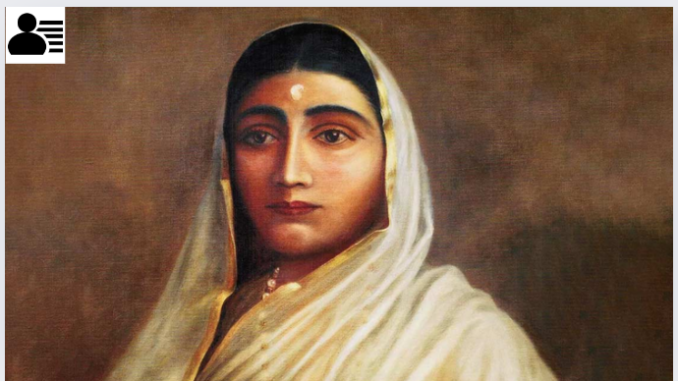
Advertisements
Ahilyabai Holkar Biography – Ahilyabai Holkar (31 May 1725 – 13 August 1795), also known as Ahalya Bai, was one of the most influential figures in Indian history. She ruled the Malwa region as the Rani of Indore and was renowned for her administrative prowess, military leadership, and devotion to the welfare of her people. Her legacy as a builder of temples and her progressive stance on women’s roles during the 18th century have made her a revered figure in Indian history.
Ahilyabai Holkar Biography
Early Life and Education
Ahilyabai was born in the village of Chaundi, in present-day Ahmednagar district, Maharashtra, on May 31, 1725. Her father, Mankoji Shinde, was the village head (Patil) and played a significant role in her upbringing. Despite the prevailing norms that restricted women’s education, Mankoji Shinde ensured that his daughter was educated. He personally taught her to read and write, a rare privilege for women of that era.
Rise to Power
Ahilyabai’s life took a significant turn when she married Khande Rao Holkar, the son of Malhar Rao Holkar, a prominent noble in the Maratha Empire. Tragedy struck when Khande Rao was killed in battle in 1754, and her father-in-law passed away in 1766. Left with the responsibility of the Holkar dynasty, Ahilyabai rose to the occasion. She took charge of the administration of Indore and the surrounding regions, proving herself to be a capable and visionary ruler.
Military Leadership and Administrative Reforms
One of Ahilyabai’s notable achievements was her military leadership. She defended her state against various intruders and led her armies into battle. Tukoji Rao Holkar, her trusted military commander, played a vital role in these campaigns. Ahilyabai’s reign was marked by significant administrative reforms that improved the lives of her subjects. She established Maheshwar as the seat of the Holkar dynasty and transformed it into a center of culture and learning.
Contributions to Architecture and Religion
Ahilyabai was a devout Hindu and a great patron of temple construction. She commissioned the building of hundreds of temples and Dharmashalas (rest houses) across India. Some of the notable temples she built include the Kashi Vishwanath Temple in Varanasi, the Vishnu Pada Temple in Gaya, and numerous others in pilgrimage sites like Ujjain, Haridwar, and Ayodhya. Her architectural projects not only enhanced the religious landscape of India but also provided essential facilities for pilgrims and travelers.
Breaking Gender Norms
In an era when women’s roles were largely confined to the domestic sphere, Ahilyabai Holkar broke traditional gender norms. She demonstrated that women could be effective leaders, administrators, and warriors. Her ability to govern effectively, lead armies, and undertake significant construction projects challenged the societal norms of her time and inspired future generations of women.
Legacy and Commemoration
Ahilyabai Holkar passed away on August 13, 1795, but her legacy continues to inspire. Her birth anniversary, Ahilyabai Holkar Jayanti, is celebrated on May 31 every year, honoring her contributions to Indian society and culture. Statues and memorials across India, particularly in Maharashtra and Madhya Pradesh, serve as a testament to her enduring impact.
FAQs About Ahilyabai Holkar
1. Who was Ahilyabai Holkar? Ahilyabai Holkar was the Rani of Indore, known for her administrative skills, military leadership, and contributions to temple construction.
2. When was Ahilyabai Holkar born? She was born on May 31, 1725, in the village of Chaundi, in present-day Ahmednagar district, Maharashtra.
3. How did Ahilyabai Holkar rise to power? After the death of her husband, Khande Rao Holkar, and her father-in-law, Malhar Rao Holkar, Ahilyabai took charge of the Holkar dynasty and proved herself as an effective ruler.
4. What were Ahilyabai Holkar’s contributions to architecture? Ahilyabai Holkar commissioned the construction of hundreds of Hindu temples and Dharmashalas across India, including notable temples like the Kashi Vishwanath Temple in Varanasi.
5. How did Ahilyabai Holkar break traditional gender norms? Ahilyabai Holkar demonstrated that women could be leaders, administrators, and warriors, challenging the societal norms of the 18th century.
Conclusion
Ahilyabai Holkar’s life is a testament to her extraordinary leadership, vision, and commitment to her people. Her contributions to Indian society, culture, and architecture are immense, and her legacy continues to inspire generations. As we celebrate her life and achievements, we remember her not just as a ruler but as a pioneer who broke barriers and set new standards for women’s roles in society.

Leave a Reply